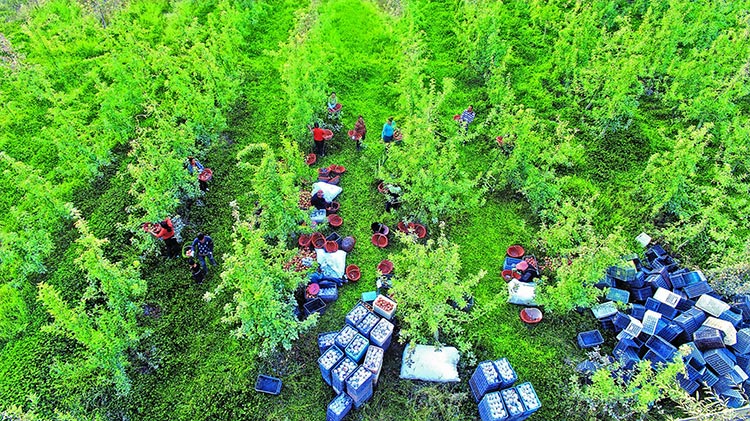Written by: Han Liang
Posted on: December 27, 2018 |  | 中文
| 中文
A View of Dolan River Mangement Project along the River
On the northeastern outskirts of Aksu City, South Xinjiang, China, shelter belts of trees form a green network, and economic forest extends like rolling waves. The 47-kilometer-wide and 50-kilometer-long green “Great Wall” that integrates ecological forests and economic forests, has become the “guardian” of beautiful Aksu Oasis and the “treasure bowl” for the local people of all ethnic groups to improve their livelihood. This green “Great Wall" is the result of Kekeya Desert Greening Project, which is also praised by the Aksu people as the “Desert Rainbow.”
The Kekeya Memorial Museum exhibits satellite remote sensing images of the greening project in different periods. Li Zongming, head of Aksu Prefectural Aerial Forest Fire Protection Station, said, "From these remote sensing images of Kekeya, people can visually see the achievements of afforestation in this area. It is a great project and has brought tremendous ecological benefits. We are proud to have participated in such a great project.”
Over the past 32 years, people from all walks of life in Aksu, including officials of government organs, employees of enterprises and institutions, teachers and students of schools, officers and soldiers of the PLA units, have struggled relentlessly in the once barren Kekeya Gobi-desert that used to be covered by yellow sand, carried out 54 voluntary tree planting and homeland greening campaigns and completed afforestation on 1.153 million mu (about 76,867 ha.) of land. Their efforts have turned a source of sandstorms into a green ecological shelter and a beautiful home for people of all ethnic groups to live and work in peace and contentment. The greening project has also won the prize of the “Global 500 Roll of Honour for Outstanding Contributions to the Protection of the Environment" by the United Nations Environment Programme (UNEP).
"With the long-range blueprint in hand, we have made consistent efforts from generation to generation and continuously advanced ecological development in Aksu area. Just as General Secretary Xi Jinping put it, ‘As long as we move in the right direction, the ecosystem can be restored if we work hard year after year and generation after generation,” said Li Zongming.

Since the 18th CPC National Congress, the spirit of Kekeya has continued to be inherited in Aksu. The prefecture has promoted ecological restoration and development with greater efforts and more practical measures, and the area of green space has increased by more than 4 million mu (about 266,667 ha.).
Today, Kekeya, a surging sea of woods with strong vitality, is speeding up its expansion to the surrounding areas and becoming a new benchmark for desert greening in China. This long-term practice of turning desert into forest has contributed a Chinese solution for ecological development to the world.
Translated by Xu Donglin
You may also like: